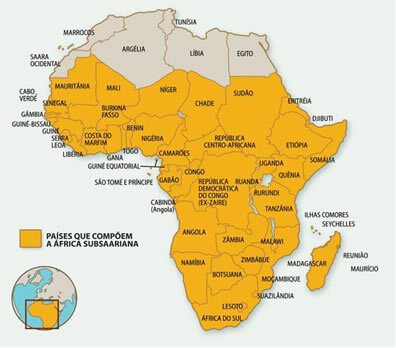With a territorial extension of approximately 30.2 million square kilometers, Africa is the third largest continent on the planet. This vast territory, inhabited by more than a billion people, has great physical, ethnic, cultural and economic diversity. All of these elements contributed to a regional subdivision, which established Mediterranean Africa (also called Islamic or Northern Africa) and Sub-Saharan Africa.

Africa map highlighting the continent's subdivision
This regionalization of the continent has the Sahara desert as a natural divider and human aspects, especially religion, as a cultural factor. Mediterranean Africa, located north of the Sahara desert, is composed of only five countries (Morocco, Algeria, Tunisia, Libya and Egypt), in addition to the territory of Western Sahara. Sub-Saharan Africa, on the other hand, comprises the entire area located south of the Sahara, corresponding to more than 75% of the continent.
The nations that make up Mediterranean Africa are bathed by the Mediterranean Sea or the Atlantic Ocean. They have physical and human characteristics similar to those of Middle Eastern nations. The climate is desert and most of the inhabitants are of Arab origin and follow Islam. Despite having problems, this portion of the continent has the best socioeconomic indicators in Africa.
Agriculture in this region is developed in the vicinity of the Nile River and in the area called Maghreb. However, the main sources of income come from the production of oil, natural gas, in addition to several other minerals: phosphate, gold, copper, etc. Tourism is another important economic activity in Mediterranean Africa, with emphasis on Egypt and Morocco, which receive millions of visitors annually.
With a mostly black population, Sub-Saharan Africa has great cultural diversity. Religious plurality is a characteristic of this continental portion, where there are Christians, Muslims (mainly in the Sahel region), Jews, in addition to various traditional beliefs. The different ethnic groups have their own dialects, dances and customs, a fact that contributes to the cultural richness of Africa. However, in some countries, various armed conflicts are triggered by different ethnic groups.
Subsoil riches drive mining. South Africa holds large reserves of diamond, chrome, platinum, gold (the world's largest producer), among other minerals. Another highlight is the large production of oil and natural gas in Sub-Saharan African countries. Tourism, promoted in the various natural parks, is another important source of financial resources.
Despite this great mineral wealth, Sub-Saharan Africa presents several socioeconomic problems and international organizations do not develop effective policies to solve them. Hunger, for example, punishes a large number of Africans, malnutrition rates are absurd in this region of the planet: Democratic Republic of Congo (76%), Somalia (72%), Burundi (63%), Sierra Leone (47%).
According to data from the United Nations (UN), of the 33.4 million people with the HIV virus in the world, 22.4 million live in sub-Saharan Africa. About 1 in 3 adults in Botswana, Lesotho, Swaziland and Zimbabwe is infected. It is estimated that the population of these countries could be reduced by 25% by 2020 as a consequence of the disease. In addition to AIDS, malaria is also responsible for the death of several inhabitants – annually, a million Africans die from the disease.
Given this scenario, the Human Development Indices (HDI) of the nations that make up Sub-Saharan Africa are the worst in the planet, a reflection of low life expectancy and per capita GDP, in addition to high illiteracy and mortality rates childish.
By Wagner de Cerqueira and Francisco
Graduated in Geography
Brazil School Team
continents - geography - Brazil School
Source: Brazil School - https://brasilescola.uol.com.br/geografia/as-duas-africas.htm

